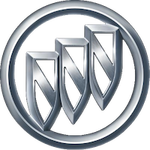 | |
| Type | Division of GM |
|---|---|
| Founded | May 19, 1903 |
| Founder(s) | David Dunbar Buick |
| Headquarters | Detroit, Michigan, United States |
| Industry | Automotive |
| Products | Luxury vehicles |
| Parent | General Motors |
| Website | buick.com |
Buick ( /ˈbjuː
ɪk/) is an entry-level luxury brand of General Motors (GM). Buick models are sold in the United States, Canada, Mexico, China, Taiwan, and Israel, with China being its largest market. Buick holds the distinction as the oldest active American make. Some current Buick models are shared with GM's German Opel subsidiary.
History[]
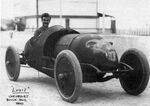
Louis Chevrolet driving a Buick Bug in the 1910 Vanderbilt Cup
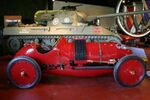
1910 Buick Bug Race Car and 1944 M18 Buick Hellcat Tank Destroyer
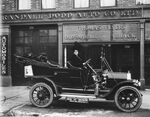
1910 Buick Model 17, at Randall-Dodd Auto Company, Salt Lake City
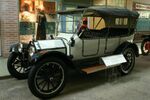
1914 Buick 5-Passenger Touring
Early years[]
Buick is currently the oldest American still-active automotive make, and among the oldest automobile brands in the world. It originated as the Buick Auto-Vim and Power Company in 1899, an independent internal combustion engine and motor-car manufacturer, and was later incorporated as the Buick Motor Company on May 19, 1903, by Scottish born David Dunbar Buick in Detroit, Michigan. Later that year, the struggling company was taken over by James H. Whiting (1842–1919),[1] who moved it to his hometown of Flint, Michigan, and brought in William C. Durant in 1904 to manage his new acquisition. Buick sold his stock for a small sum upon departure, and died in modest circumstances twenty-five years later.
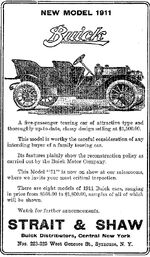
A 1911 Buick Advertisement - Syracuse Post-Standard, January 21, 1911
Between 1899 and 1902 two prototype vehicles were built[2] in Detroit, Michigan by Walter Lorenzo Marr. Some documentation exists of the 1901 or 1902 prototype with tiller steering[3] similar to the Oldsmobile Curved Dash.
In mid-1904 another prototype was constructed for an endurance run, which convinced James H. Whiting to authorize production of the first models offered to the public.[4] The architecture of this prototype was the basis for the Model B.
The first Buick made for sale, the 1904 Model B, was built in Flint, Michigan.[5] There were 37 Buicks made that year, none of which survived. There are, however, two replicas in existence: the 1904 endurance car, at the Buick Gallery & Research Center in Flint, and a Model B assembled by an enthusiast in California for the division's 100th anniversary.[6][7][8] Both of these vehicles use various parts from Buicks of that early era, as well as fabricated parts. These vehicles were each constructed with the two known surviving 1904 engines.
The power-train and chassis architecture introduced on the Model B was continued through the 1909 Model F.[9] The early success of Buick is attributed in part to the valve-in-head engine[10] patented by Eugene Richard. The creation of General Motors is attributed in part to the success of Buick,[11] so it can be said Marr and Richard's designs directly led to GM.[12]
The basic design of the 1904 Buick was optimally engineered even by today's standards. The flat-twin engine is inherently balanced, with torque presented to the chassis in a longitudinal manner, actually cancelling front end lift, rather than producing undesirable lateral motion. The engine was mounted amidships, now considered the optimal location.[13]
Durant was a natural promoter, and Buick soon became the largest car maker in America. Using the profits from this, Durant embarked on a series of corporate acquisitions, calling the new mega-corporation General Motors. At first, the manufacturers comprising General Motors competed against each other, but Durant ended that. He wanted each General Motors division to target one class of buyer, and in his new scheme Buick was near the top — only the Cadillac brand had more prestige. This is the position that Buick occupies to this day in the General Motors lineup. The ideal Buick customer is comfortably well off, possibly not quite rich enough to afford a Cadillac, nor desiring the ostentation of one, but definitely in the market for a car above the norm.
At first, Buick followed the likes of Napier in automobile racing, winning the first-ever race held at Indianapolis Motor Speedway.[14]
In 1911, Buick introduced its first closed-body car,[15] four years ahead of Ford.[16] In 1929, as part of General Motors' companion make program, Buick Motor Division launched the Marquette sister brand, designed to bridge the price gap between Buick and Oldsmobile; however, Marquette was discontinued in 1930. Buick scored another first in 1939, when it became the first[citation needed] company to introduce turn signals.[17]
Recent years[]

1987 Buick Regal Grand National.
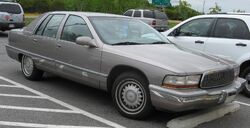
1995–1996 Buick Roadmaster.

1998–2002 Buick Park Avenue.
Overall sales of the Buick brand peaked in the 1984 model year, with the popular styling of the Buick Regal and Oldsmobile Cutlass Supreme, in combination with the popularity of newer, smaller offerings and performance oriented turbocharged models. Buick Regal Grand National was Buick's muscle car, the fastest production car at one time. Equipped with a 3.8L V-6 engine with a turbo charger, the FBI had a GN with twin turbo chargers. From 1986 to 1987, the 5.0 L 307 V-8 was available as an option on the Buick Regal.
The number of Buick models in the lineup fell over time, with the compact and performance segments being abandoned altogether. By the 2000s, Buick was a traditional luxury brand in the GM group, emphasizing comfort and safety, whereas Cadillac has focused more on cutting edge products that were performance oriented and avante-garde styled. The Buick LaCrosse is slotted against the Lexus ES, while Cadillac, with its CTS, is slated against luxury performance imports from European manufacturers such as Mercedes and BMW, and Japanese luxury performance imports such as the Lexus GS and Infiniti M
Buick introduced its first SUV in 2001, the Buick Rendezvous crossover, which provided the much-needed success for the marque, and single handedly brought a large number of younger, wealthier "conquest" buyers into Buick showrooms who otherwise wouldn't have considered purchasing a Buick. Certainly a major contributor to the Rendezvous's success was an aggressive value-pricing strategy that made the Rendezvous US$6,500 less than a comparably equipped Acura MDX and US$8,000 less than the Lexus RX300. The Rendezvous handily exceeded GM's predictions of 30,000 to 40,000 units a year by a large margin, which helped offset the poor sales of the Pontiac Aztek with which it shared its Ramos Arizpe, Mexico, assembly line. Commercials featuring Tiger Woods aired during the Buick Classic golf tournament. The truck-based Buick Rainier was added to the lineup in 2004.
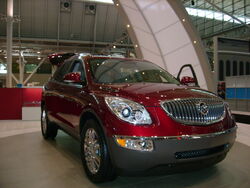
The 2008 Buick Enclave crossover has been a much needed sales success for Buick.

The 2010 Buick LaCrosse. Buick states that the second generation LaCrosse will be "America's Lexus fighter".

2012 Buick Regal GS.
Buick began consolidating its lineup in 2005, replacing the Century and Regal with the LaCrosse/Allure, and the LeSabre and Park Avenue with the Lucerne in 2006. Both of its SUVs, the unibody Rendezvous and truck-based Rainier were discontinued in 2007 to make way for the new and highly successful 2008 Enclave, while the slow-selling Terraza minivan was also dropped for 2008. This left the marque with just three models in the United States. In 2008, Buick sales slipped from an average of four cars per dealer per month to three, in addition to two trucks.[18]
Since 2005, GM has gradually consolidated Buick with GMC and former Pontiac dealerships to create the current Buick-GMC network. Following General Motors Chapter 11 reorganization and emergence in 2009, the company selected the Buick division to consolidate and provide a new line-up that would attract a younger customer base. Buick's success in China and its market niche in North America became significant reasons for Buick to reinvent itself in order to take on a larger role within General Motors.[19]
In January 2009, Buick unveiled the new 2010 LaCrosse sedan, an all new styling direction. After its first year in production, the car has drawn praise from enthusiasts and critics, auto journalists and satisfied owners, significantly lowering the age demographic and broadening Buick's customer base. Another bright spot for Buick, especially when the car was compared to the similarly placed Lexus ES, the LaCrosse emerged the winner on nearly all counts. Meanwhile, sales of the luxury crossover Enclave have increased each year. The re-introduction of the Regal has reinforced Buick's image as an upscale competitor.
In the 2009 J.D. Power and Associates Vehicle Dependability Study, Buick tied with Jaguar as the most dependable brand in the United States.[20] Additionally, as of this writing, demand has been strong and in 2010, Buick surprised analysts everywhere when it was revealed that Buick sales had grown 60.8% in 2010, making them the fastest growing automotive make by a wide margin.
At its extended product review in August 2009, GM announced Buick's future lineup. LaCrosse and Lucerne models will continue in production to cater to Buick's traditional upper medium price/entry-level luxury markets. The Regal has returned to strong demand and its GS version will be the first Buick in almost 20 years to be offered with a manual transmission and a turbocharger. Buick will also be offering a new compact sedan that will be assembled in China.[21] With LaCrosse-based styling, it will be targeted against the Acura TSX and Volvo S60. In worldwide sales, Buick showed a huge resurgence during the months following the release of the new LaCrosse. Now although, Buick has hinted that the Lucerne will soon be discontinued. Also, there are two other concepts: the Buick Verano, a compact sedan; and the unnamed small crossover, expected in 2013-2014.
Currently, Buick's North American lineup consists of: the Regal entry-level luxury/sports sedan, the LaCrosse mid-size luxury sedan, Lucerne full-size luxury sedan, and Enclave full-size luxury crossover. There current definite future vehicles: the Buick Verano, compact luxury sedan; the Buick Regal GS, a entry-level luxury/sport sedan turbo version of the Regal.
Distinguishing features[]
Trishield[]

Trishield, Buick´s emblem
The Buick trishield is rooted in the ancestral coat of arms of the automaker’s founder, David Dunbar Buick. That crest was a red shield with a checkered silver and azure diagonal line from the upper left to lower right, a stag above and a punctured cross below. The division adopted this on its radiator grilles in 1937. In 1960, the logo underwent a major overhaul. Its single shield was replaced by a trio in red, white and blue—denoting the LeSabre, Invicta, and Electra then in the Buick lineup. Usurped by the Buick Hawk in the 1970s, the trishield reemerged in the 1980s, simplified, but with its same patriotic colors. Today, again representing the trio of vehicles in the Buick marque, the trishield enjoys its even more distilled—and emboldened—monochrome form.
Portholes and ventiports[]
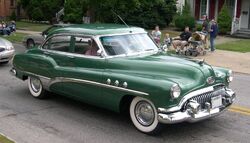
Buick Special or Super Sedan, 1951.
A traditional Buick styling cue dating to 1949 is a series of three or four portholes or vents on the front fender behind the front wheels. The source of this design feature was a custom car of Buick stylist Ned Nickles, which in addition had a flashing light within each hole each synchronized with a specific spark plug simulating the flames from the exhaust stack of a fighter airplane. Combined with the bombsight mascot (introduced in the 1940s), the ventiports put the driver at the controls of an imaginary fighter airplane. The flashing light feature was not used by Buick in production, but the portholes remained as nonfunctional ornamentation.
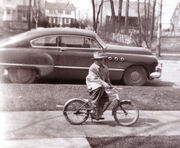
1949 Buick with ventiports (1952).
These were originally called "Ventiports" since the suggestion was made that they did allow air flow out of the engine bay (later just "portholes"). Air enters from the grill into the engine bay and is pressurized by the radiator fan, and exits through the ventiports. Ventiports have appeared sporadically on several models since and are currently featured on three of the four current Buick models.
Lower cost models were equipped with three portholes, while higher cost models came with four. Often, people would denote their cars as "Four-Holers" or "Three-Holers" to assert the car's class. When the number of portholes was standardized across the entire model line, buyers of the higher cost models complained bitterly that they felt shortchanged. In 2003 they were re-introduced on the Buick Park Avenue. After the Park Avenue was discontinued, Buick salvaged the portholes to appear on the new-for-2006 Lucerne. In a break with tradition, the Lucerne's portholes refer directly to engine configuration: V6 models have three on each side, while V8s have four on each side.
Modern and edgy compared to the oval ones that adorned Buicks for years, the new ventiports have become a Buick-wide talisman again and are currently featured in one form or another on the Lucerne, the popular Enclave and, for 2010, along the inner hood ridges of the redesigned LaCrosse.
Sweepspear[]
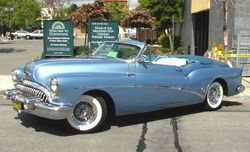
"Sweepspear" on a Buick Skylark.
Another styling cue from the 1940s through the 1970s was the "sweepspear", a curved line running the length of the car. In the earlier cars, this was a chrome-plated or stainless steel rub strip which, after it passed the front wheel, gently curved down nearly to the rocker panel just before the rear wheel, and then curved around the rear wheel in a quarter of a circle to go straight back to the tail-light. During the two-tone color craze of the 1950s, the sweepspear separated two different color areas. After that, the curved line was usually indicated either by a vinyl rub strip or simply a character line molded into the sheetmetal as hinted in the 2008 Invicta concept car and 2010 LaCrosse/Allure production car.
Delta fins[]
The 1958 Buick was marketed beginning in September 1957, just as the space age began with the launching of Sputnik I on October 4 of that year. This Buick was nicknamed "the king of chrome" and had rear tailfins that reminded one of a rocket ship.[22][23] In 1959, Buick had the aerodynamic Delta Fin. The fin made parking difficult and blocked the driver's line of vision.[24][25] In 1960, the fin was snubbed down and disappeared in 1961, although vestiges of it reappeared in the 2000-2005 LeSabre line with its upswept sides.
Taillight shapes[]
During the 1950s, the characteristic form of the Buick taillamps was a tier of small, circular bullet-shapes. In the early 1960s, most models began to evolve a wide, rectangular pattern, until the '65 Skylark and Electra models appeared with full-width rear lamps. Since then, wide taillamps have been a Buick hallmark.
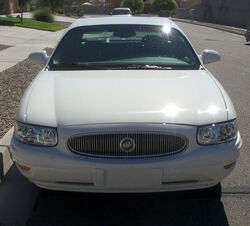
Buick "dollar grin" and Trishield in a Buick LeSabre
Dollar grin[]
The Buick styling cue (dating from the 1940s) that has most often reappeared, though, is for the grille to be a horizontal oval with many thin vertical chromed ribs bulging forward. This has sometimes been called the Buick "dollar grin" particularly on the early 1950s models, which had thick, highly-polished ribs that somewhat resembled teeth. The 1950 model took this tooth theme to its extreme as the teeth crossed over the bumper exposing the 1950 "grin". The 1951 model reined in the theme, bringing the teeth back behind the bumper.

1987 Buick Regal Grand National
Waterfall grille[]
It appears Buick may be preparing to abandon this styling cue for a new waterfall grille, as seen on the Buick Velite concept car from 2004 and the Buick Lucerne introduced for the 2006 model year. This waterfall grille bears some resemblance to grilles of Buicks from the 1980s, such as the Grand National. It was reintroduced on the 2010 Buick LaCrosse and 2010 Buick Enclave
Nailhead[]
The Buick V8 engine, nicknamed the "nailhead" because of its relatively small intake and exhaust valves which resembled nails, became popular with hot-rodders in the 1950s and 1960s, because the vertical attachment of the valve covers, in contrast to the angled attachment of other V8 engines, enabled the engine to fit into smaller spaces while maintaining easy access for maintenance.

Buick Gran Sport, 1970 455 Stage 1
By 1967, Buick was making quiet history with more conventional V8s that had abandoned the "nailhead" design but made much greater power. For the 1967 model year, Buick re-named its "Gran Sport" performance models (not to be confused with the Chevrolet "Super Sport" cars) as "GS" models. In 1970 this was headed up by the powerful GS455 Stage 1, so named for its 455 cubic inch (7.4L) engine, with its high performance "Stage 1" package. Built on the same "A-body" platform as the Chevelle, Cutlass/442, and LeMans/GTO, the GS cars were performance based vehicles spawned from Buick's Skylark line, and shared all of the A-Body GM offering's tendency for good looks. Both hardtop and convertible "GS" models were offered.
GSX[]
Midway through that year, Buick debuted its "GSX" model, which was an appearance package rivaling that of the GTO "Judge". GSX colors ran the spectrum that year, if that range included just yellow and white. Subsequent GSX models offered a variety of colors to go with the GSX signature hood blackout treatment and the swept wide pin striping vaguely reminiscent of the famous Buick "sweepspear". GSX models could be ordered with 350, 455, or 455 Stage 1 engines, and were outfitted with the usual GS options such as dual hood scoop hood with functioning "ram-air" intake, and dual exhaust. Horsepower ratings for the Stage 1 455s were a relatively mild 360 hp (or 370 depending on sources), but featured 510 ft·lbf (690 N·m) of torque at 2200 rpm, good to propel the relatively weighty GS455 Stage 1 equipped cars to quarter-mile times of under 13.4 seconds. Buick halted GSX production after the 1972 model year.
The prototype GSX survived the show circuit, and was a fully functioning car that beat the odds to survive not only the usual showcar life of "construction-display-destruction", but also the life of an ordinary car, as it was sold from a dealership after being on display for some time. The car survives to this day, is restored to its original condition, licensed and ready to hit the road.

1965 Buick Special convertible.
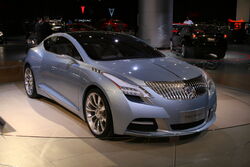
2007 Buick Riviera concept.
Geographical distribution[]
Unlike some of GM's other brands, Buicks are currently not marketed globally, although the marque had a substantial export presence until a few years ago. Some Buicks were also built in Europe or were available with specific trim for European market until 1996.
In pre-World War II China, one in five cars was a Buick. The brand is popular in China today.[26]
Buick in Mexico[]
Buicks were sold in Mexico from 1921 to 1962 when a protectionist policy on behalf of the government restricted the percentage of imported parts that could be used in the manufacture of vehicles and the sale of imported cars. From then onwards, all GM products were sold by Chevrolet dealerships. In 1990, after a heavy modification to the protectionist policy of the sixties, GM started assembling the Buick Century in Mexico, at the plant in Ramos Arizpe, in the state of Coahuila, just south of Texas, and selling it through Mexican Chevrolet dealerships, so it was not uncommon for many people to call it "Chevrolet Century". In 1997, GM stopped production of Buicks in Mexico and the brand was not sold there until 2009.
With the announcement in 2009 of the elimination of the Pontiac brand, it was speculated that Buicks would be sold once again in Mexico, since there was a large network of Pontiac-GMC dealerships already in place. On July 24, 2009, Grace Lieblein, the new president of GM in Mexico, revealed that the Buick brand would be available in Mexico in late September of that year, after an absence of a dozen years, with the LaCrosse and the Enclave models. Buick shares the dealership floor with Pontiac and GMC until the Pontiac brand fades away during the summer of 2010.
Buick in New Zealand[]
Buicks were once sold in New Zealand. They were also built at the GMNZ plant in Petone, outside Wellington.[27] At the end of World War II, the Buick name was not revived for the New Zealand market.
Buick in Israel[]
In Israel, Buicks are imported by Universal Motors, Ltd. (UMI), which also imports other GM vehicles. For model years 2004 and 2005, the Buick LeSabre and Buick Rendezvous were sold. For model years 2006 and 2007, the Buick LaCrosse and Buick Lucerne were sold alongside the Rendezvous. For model year 2008, the Buick LaCrosse and Buick Lucerne were available.
Buick in the Middle East[]
Buicks were sold throughout the Middle East until the second-generation Buick Roadmaster was discontinued.
Buick in Mainland China[]

Buick car of Chinese version

Buick G2.5 v6 made by Shanghai GM, China in 2002
General Motors, selling vehicles under the Buick, Chevrolet, and Cadillac names, is the best-selling foreign automaker in China. Selling a combined 876,000 vehicles in 2006, GM overtook Volkswagen the year before, although that company still holds the claim on best selling brand.[28][29] Making up nearly 35% of those sales, China is Buick's largest market, selling more there than even the United States.[30] In 2007, General Motors sold over 330,000 Buicks in China, more than twice what they sold in the United States.[31]

v6 engine of Buicck 2.5G of Shanghai GM, China in 2002
Since 1999, a Chinese version of the Buick Century/Regal has been produced and sold in China by Shanghai GM and has proven to be popular among upscale, professional families, establishing Buick as one of the most popular vehicle brands in China. In addition, Buick of China also sells the compact Excelle (based on the Daewoo Lacetti/Nubira), a five-door hatchback version called the HRV, and a modified version of the first generation Pontiac Montana minivan named the GL8. Many Buicks for the local market are equipped with smaller more fuel efficient engines with double overhead camshafts, than those with overhead valves in the same nameplate for the American market. The engines of 2005-09 Chevrolet Equinox and Pontiac Torrent, originally intended for Buick in China, were made in China and imported by General Motors.[32]
In June 2005, Buick announced that it would market the Australian RWD Holden Caprice in China as the Buick Royaum (2005–06). Buick previously marketed the subcompact Sail, sourced from GM's Asian operations and based on the Opel Corsa B, until 2005. Since then, Shanghai GM has replaced it with the Chevrolet Sail (a rebadged Opel Corsa). Buick has stated that it expects China to become its second largest market.
In 2006, Buick debuted the Chinese version of the LaCrosse sedan. The only differences are exterior design, different engine choices, and a facelifted interior. It is positioned above the Regal but below the Royaum.
In April 2007, Shanghai GM announced the Buick Park Avenue, for the Chinese market only. The vehicle is based on the Holden Caprice, with engines manufactured in Australia.
In 2009, Buick sold 447,011 vehicles, an increase of 59.6 percent compared with the previous year.[33]
Buick has sold over two million vehicles in China. The first million took eight years, the second came in at only three years.[34]
Buick in Taiwan[]
GM Taiwan was founded in August 1989. In the early 1990s, Buick, along with other GM brands, was very popular and frequently seen on Taiwanese streets. Park Avenue, 3rd and 4th generation Regal, and 6th generation Skylark used to be sold in Taiwan.
In December 2004, General Motors signed a memorandum of understanding with Yulon Motors, a firm based in Taiwan, for the licensed manufacture of Buick vehicles there. In July 2005, Yulon GM Motor Co. Ltd. (Yulon GM), a joint venture with 51 percent equity stake held by Yulon Motor and 49 percent by GM, was founded.
On April 17, 2006, Yulon GM debuted the first Buick vehicle ever built in Taiwan, the LaCrosse sedan. It is very similar to the Chinese version of the LaCrosse.
See also[]
- List of automobile manufacturers
- Harley Earl
References[]
| This page uses some content from Wikipedia. The original article was at Buick. The list of authors can be seen in the page history. As with Tractor & Construction Plant Wiki, the text of Wikipedia is available under the Creative Commons by Attribution License and/or GNU Free Documentation License. Please check page history for when the original article was copied to Wikia |
- ↑ Flint Timeline Project-James H. Whiting[dead link]
- ↑ "Buick History". Welovebuicks.com. Retrieved on 2010-10-16.
- ↑ "1901 Buick perhaps 1902". Prewarbuick.com (2002-01-01). Retrieved on 2010-10-16.
- ↑ "James H. Whiting". Thewhiting.com. Retrieved on 2010-10-16.
- ↑ "1904 Buick Model B". Prewarbuick.com (2002-01-01). Retrieved on 2010-10-16.
- ↑ "1904 Buick Prototype - Sloan Museum". 1929buick.com. Retrieved on 2010-10-16.
- ↑ Buick's Flint Centennial Celebration Detailed[dead link]
- ↑ "1904 Buick Model B - Restoration Project". 1929buick.com. Retrieved on 2010-10-16.
- ↑ Katz, John F. (1998-03-02). "1909 Buick Model F". Autoweek.com. Retrieved on 2010-10-16.
- ↑ "A Heritage of Precision". Buick. Retrieved on 2010-10-16.
- ↑ "The free-wheeling gambler who created conservative General Motors". Info.detnews.com (1996-07-30). Retrieved on 2010-10-16.
- ↑ Stoll, John D. (2008-07-07). "GM Weighs More Layoffs, Sale of Brands". Online.wsj.com. Retrieved on 2010-10-16.
- ↑ "Buick History (1904-1929)". 1929buick.com. Retrieved on 2010-10-16.
- ↑ Wells, Dick. "SRMA Update" in Street Rodder, 12/98, p.298. The accuracy of this source is in question, however.
- ↑ Clymer, Floyd. Treasury of Early American Automobiles, 1877-1925 (New York: Bonanza Books, 1950), p.121.
- ↑ Clymer, p.120.
- ↑ Motor Trend, 4/84, p.6.
- ↑ "Buick and the Detroit Zombies", Andrew Dederer, The Truth About Cars, April 25, 2008
- ↑ "Buick's New Baby: Due For U.S. In Late 2011 - With A New Name | Car News Blog at Motor Trend". Blogs.motortrend.com (2010-04-23). Retrieved on 2010-09-13.
- ↑ "Buick and Jaguar Tie to Rank Highest for Vehicle Dependability", J.D. Power Press Release, 19 March 2009
- ↑ "On the Scene: Some details from GM's product preview". Leftlanenews.com (2010-08-11). Retrieved on 2010-09-13.
- ↑ "Photo of a 1958 Buick Special". Retrieved on 2010-12-27.
- ↑ Source of the photo of the 1958 Buick
- ↑ "Photo of a 1959 Buick". Retrieved on 2010-12-27.
- ↑ Source of the photo of the 1959 Buick—David’s Dimension Classic Car Images:
- ↑ Peter Alexander (2006-05-15). "Buick bucks the trend — GM brand is No. 1 car seller in China, thanks to smart marketing". NBC News. Retrieved on 2008-10-11.
- ↑ http://www.magnetdesign.co.nz/.+"Heart of Holden - Heritage | Holden New Zealand". Holden.co.nz. Retrieved on 2010-09-13.
- ↑ "General Motors Sells Record 876,747 Vehicles in China in 2006". GM China Press Release. Retrieved on April 10, 2007.
- ↑ "GM becomes top-selling foreign automaker in China". Detroit News. Retrieved on April 10, 2007.
- ↑ "China could save a tarnished GM brand", Roland Jones, MSNBC.com, Dec. 20,2006
- ↑ "GM finds surprising success in China". MSNBC (2008-08-05). Retrieved on 2008-09-17.
- ↑ "A Chevy With an Engine From China", Ian Austen, New York Times, March 26, 2008
- ↑ Cheryl Jensen (2010-04-23). "Forecast Says China Provides Opportunities and Competition", New York Times Wheels blog. Retrieved on 2010-04-23.
- ↑ "GM hits two million sells in China". Autoblog (2009-06-22). Retrieved on 2009-10-18.
External links[]
| Buick road car timeline, 1940s–1980s — next » | ||||||||||||||||||||||||||||||||||||||||||||
|---|---|---|---|---|---|---|---|---|---|---|---|---|---|---|---|---|---|---|---|---|---|---|---|---|---|---|---|---|---|---|---|---|---|---|---|---|---|---|---|---|---|---|---|---|
| Type | 1940s | 1950s | 1960s | 1970s | 1980s | |||||||||||||||||||||||||||||||||||||||
| 6 | 7 | 8 | 9 | 0 | 1 | 2 | 3 | 4 | 5 | 6 | 7 | 8 | 9 | 0 | 1 | 2 | 3 | 4 | 5 | 6 | 7 | 8 | 9 | 0 | 1 | 2 | 3 | 4 | 5 | 6 | 7 | 8 | 9 | 0 | 1 | 2 | 3 | 4 | 5 | 6 | 7 | 8 | 9 | |
| Subcompact | Skyhawk | |||||||||||||||||||||||||||||||||||||||||||
| Compact | Special | Skyhawk | ||||||||||||||||||||||||||||||||||||||||||
| Apollo | Somerset | |||||||||||||||||||||||||||||||||||||||||||
| Skylark | Skylark | Skylark | Skylark | |||||||||||||||||||||||||||||||||||||||||
| Mid-size | Special | Special | Century | Century | Century | |||||||||||||||||||||||||||||||||||||||
| Skylark | Skylark | Regal | Regal | Regal | ||||||||||||||||||||||||||||||||||||||||
| Full-size | Special | Special | Special | LeSabre | LeSabre | LeSabre | LeSabre | LeSabre | ||||||||||||||||||||||||||||||||||||
| Century | Invicta | |||||||||||||||||||||||||||||||||||||||||||
| Super | Super | Super | Wildcat | Centurion | Electra | |||||||||||||||||||||||||||||||||||||||
| Roadmaster | Roadmaster | Roadmaster | Electra | Electra | Electra | Electra | Estate Wagon | |||||||||||||||||||||||||||||||||||||
| Personal | Skylark | Limited | Riviera | Riviera | Riviera | Riviera | Riviera | Riviera | ||||||||||||||||||||||||||||||||||||
| « previous — Buick, a division of General Motors, automobile timeline, United States market, 1980s–present | ||||||||||||||||||||||||||||||||
|---|---|---|---|---|---|---|---|---|---|---|---|---|---|---|---|---|---|---|---|---|---|---|---|---|---|---|---|---|---|---|---|---|
| Type | 1980s | 1990s | 2000s | 2010s | ||||||||||||||||||||||||||||
| 0 | 1 | 2 | 3 | 4 | 5 | 6 | 7 | 8 | 9 | 0 | 1 | 2 | 3 | 4 | 5 | 6 | 7 | 8 | 9 | 0 | 1 | 2 | 3 | 4 | 5 | 6 | 7 | 8 | 9 | 0 | 1 | |
| Subcompact | Skyhawk | |||||||||||||||||||||||||||||||
| Compact | Skyhawk | |||||||||||||||||||||||||||||||
| Somerset | ||||||||||||||||||||||||||||||||
| Skylark | Skylark | Skylark | ||||||||||||||||||||||||||||||
| Mid-size | Century | Century | Century | Regal | ||||||||||||||||||||||||||||
| Regal | Regal | Regal | LaCrosse | LaCrosse | ||||||||||||||||||||||||||||
| Full-size | LeSabre | LeSabre | LeSabre | LeSabre | Lucerne | |||||||||||||||||||||||||||
| Electra | Electra | Park Avenue | Park Avenue | |||||||||||||||||||||||||||||
| Estate | Estate/Roadmaster | |||||||||||||||||||||||||||||||
| Personal | Riviera | Riviera | Riviera | |||||||||||||||||||||||||||||
| Crossover | Rendezvous | Enclave | ||||||||||||||||||||||||||||||
| SUV | Rainier | |||||||||||||||||||||||||||||||
| Minivan | Terraza | |||||||||||||||||||||||||||||||
| Sports | Reatta | |||||||||||||||||||||||||||||||
| |||||||||||||||||
| |||||||||||

